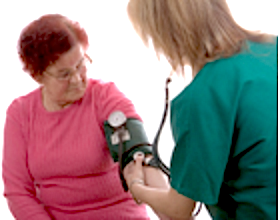
Intensive therapy to reduce high blood pressure can reduce the risk of heart disease in older adults without increasing the risk for falls, according to the results of a new study published online Thursday by JAMA.
In the United States, 75% of people aged 75 or more years have hypertension, but current guidelines have provided inconsistent recommendations regarding the optimal systolic blood pressure treatment target in this age group, according to researchers. One group recommends a target blood pressure of 160 mm Hg for those aged 80 or more years, another recommends a target of 150 mm Hg for adults aged 60 or more years, and other experts support keeping the standard treatment goal at 140 mm Hg.
A subgroup analysis of data from the National Institutes of Health’s Systolic Blood Pressure Intervention Trial, also known as SPRINT, included 2,636 participants aged at least 75 years who had high blood pressure but no diabetes and no history of stroke. Researchers found that adjusting the amount or type of blood pressure medication to achieve a target systolic pressure of 120 mm Hg reduced rates of heart attack, heart failure and stroke by 33% and the risk of death by 32%, as compared with a target systolic pressure of 140 mm Hg. Further, the intensive blood pressure treatment did not significantly increase risk for injurious falls and other serious side effects, even among participants deemed the most frail.
“Most of the medications used in SPRINT were generic, so this is a fairly inexpensive way to help prolong the time that people can live independently in their homes and avoid those common conditions that often cause a person to have to move to higher level of care or an institution,” said the study’s lead author, Jeff Williamson, M.D., a professor of gerontology and geriatric medicine at Wake Forest Baptist.
Similar results had been reported previously in those who were aged 50 or more.
“This subgroup analysis of the SPRINT trial is significant because many physicians and patients have been concerned about blood pressure being too low in the elderly,” said Alfred Cheung, M.D., chief of nephrology and hypertension at University of Utah Health Care and a member of the SPRINT Research Group.
Williamson said that the findings have “substantial implications” for the way high blood pressure is treated in older adults in the future. “If you look at elderly people who are hospitalized in the year that they become disabled and have to leave their home, about half the time those diagnoses or hospitalizations result from complications of hypertension, like heart failure, stroke and heart attack,” he added.
Whether national medical guidelines will change remains to be seen, however, and the researchers advise people who have hypertension to talk with their doctors to determine whether the lower goal is appropriate for them.



